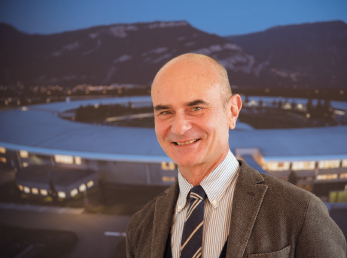Introduction

Dear Reader
Twenty years after its inauguration, the ESRF, in 2014, welcomed the Russian Federation as a new Member State. It also reached important milestones in the delivery of Phase I of the Upgrade Programme (UP) and has proudly announced the launch of Phase II. In parallel, the excellent operation of the facility throughout the year enabled the ESRF users to carry out their scientific programmes very successfully. Over 2000 proposals were submitted by ESRF users in 2014. This figure is the highest ever reached, and puts the number of proposals at more than two and a half times the available beam time.
The achievements of 2014 are the result of the hard work of thousands of people among the ESRF Users and Staff, and would not have been possible without the support provided by our partner countries. Following on from these achievements, we are now excited about the prospects for 2015, which will see the completion of UP Phase I, the start of UP Phase II construction, and full-scale user operation for the ESRF accelerators and available beamlines.
The ESRF Council endorsed the UP Phase II deliverables, timescale and budget envelope in June 2014 following the science case and construction planning described in the UP Phase II Technical Design Study report, the ‘Orange Book’. At the subsequent Council meeting in December 2014, the first financial contribution to the UP Phase II budget was approved. Over the next eight years (2015-2022), the ESRF plans to bring into operation a new synchrotron X-ray source, housed in the existing buildings and replacing the present machine that has been in operation since 1992, as well as four new beamlines and an ambitious instrumentation programme. The objective is to deliver a fully renewed facility by 2023 for the benefit of scientific users from around the world, and to enable the ESRF to remain a global leader in synchrotron X-ray science for many years to come.
Alongside the preparation work for UP Phase II, in 2014, many developments took place within the context of the implementation of UP Phase I. New instruments were delivered, and in particular, I wish to highlight the restart of user operation at the new beamlines ID01, ID02, ID16A/B, ID22, ID30A and ID32. With respect to the opening of ID30A, part of the MASSIF complex at ID30, the macromolecular crystallography community will benefit from the first public experimental station in the world that is completely automated. In fact, beyond remote access, users can now send in their samples, have them analysed automatically using instructions given in the ISPyB database, and then log on to discover and review their results. This new facility has the potential to save hours, or even days of users’ valuable time. It has been designed particularly for the initial screening of crystals and the collection of data sets from reasonably well-known samples. Since it opened in late October, 500 samples have already been processed. ID30A has three end stations and, with BM29, replaces the highly successful ID14 complex that was closed at the end of 2012.
UP Phase I continues to progress according to schedule, with the goal of its completion by the end of 2015. During 2015, therefore, the few remaining Phase I beamlines will be commissioned, and by early 2016 the topping-up of the storage ring will become part of normal user operation.
The new joint ESRF-ILL Science Building and the new site entrance of the EPN Science Campus, entirely financed by the French State (CPER Programme) to increase the visibility and attractiveness of the campus, was inaugurated in February 2014 by the French Minister for Higher Education and Research, the President of the Rhône-Alpes Region and the local authorities. The Science Building will foster new collaboration and closer working relations between the two facilities, their scientific user communities as well as with industry. ESRF users can now access the Science Building from the ESRF thanks to a covered footbridge. This footbridge provides access to the new library, new chemistry labs and the new facilities of the Partnership for Soft Condensed Matter (PSCM). Thanks to the CPER Programme, the ESRF has also been made more accessible to users coming from and going into town since the completion, in September 2014, of an extension of one of Grenoble’s tram lines.
I wish to thank our colleagues in charge of the operation of the storage ring for the outstanding performance in beam delivery. Indeed, during 2014 they were able to establish a new world record with 99.15% beam availability with enhanced beam properties. The excellent beamline and beam delivery performance have enabled excellent scientific results. A selection of them is presented here in Highlights to record and applaud the wonderful scientific advances of the ESRF Users.
Twenty years after its inauguration, the ESRF, in 2014, welcomed the Russian Federation as a new Member State. It also reached important milestones in the delivery of Phase I of the Upgrade Programme (UP) and has proudly announced the launch of Phase II. In parallel, the excellent operation of the facility throughout the year enabled the ESRF users to carry out their scientific programmes very successfully. Over 2000 proposals were submitted by ESRF users in 2014. This figure is the highest ever reached, and puts the number of proposals at more than two and a half times the available beam time.
Francesco Sette,
ESRF Director General.



